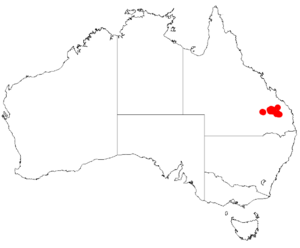Acacia calantha facts for kids
Quick facts for kids Acacia calantha |
|
|---|---|
| Scientific classification | |
| Genus: |
Acacia
|
| Species: |
calantha
|
 |
|
| Occurrence data from AVH | |
Acacia calantha is a type of shrub found in Queensland, Australia. It belongs to the Acacia family, which is well-known for its wattles.
What Does Acacia calantha Look Like?
This shrub is quite bushy and usually grows between 1 and 3 meters (3 to 10 feet) tall. Its branches are thin and smooth, ranging from yellowish-brown to grey. The leaves, called phyllodes, are green to grey-green. They are long and narrow, like threads, measuring about 7 to 15 centimeters (3 to 6 inches) long and only about 1 millimeter wide. Each phyllode has a clear line down the middle. When they dry, these lines become more noticeable, forming three or four distinct ridges.
The flowers of Acacia calantha are bright golden and grow in small, round clusters. Each cluster looks like a single ball of flowers and has about 30 tiny blooms. After the flowers, long, thin seed pods appear. These pods can be up to 6 centimeters (2.4 inches) long and about 5 to 6 millimeters wide. Inside the pods are dark brown to black seeds. These seeds are shaped like tiny oblongs or ovals, about 3 to 4 millimeters long.
How Was Acacia calantha Named?
The plant was first officially described in 1979 by a botanist named Leslie Pedley. He wrote about it in a scientific journal called Austrobaileya. Later, in 1987, Pedley changed its name to Racosperma calanthum. However, in 2001, scientists decided to move it back to its original name, Acacia calantha.
Where Does Acacia calantha Grow?
This shrub naturally grows in an area near Cracow in southeastern Queensland, Australia. It is found in the Dawson River area. You can often spot it on the lower parts of steep hills and ridges made of sandstone. It prefers sandy or sandy-clay soils.
Acacia calantha is part of dry sclerophyll forest communities. This means it grows alongside other specific trees and plants. Some of its common neighbors include Corymbia maculata, Corymbia trachyphloia, Eucalyptus crebra, Eucalyptus cloeziana, Eucalyptus citriodora, Corymbia tessellaris, Angophora leiocarpa, Lysicarpus angustifolius, Acacia podalyriifolia, and Acacia crassa.

